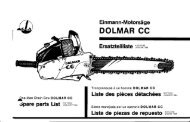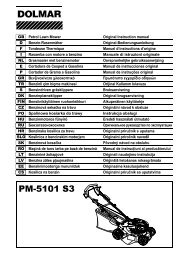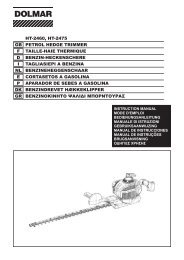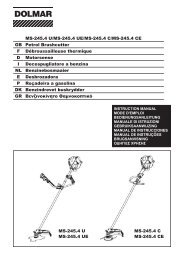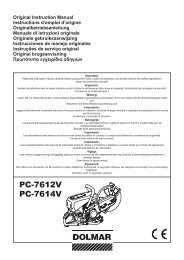DA301D DA391D
DA301D DA391D
DA301D DA391D
Create successful ePaper yourself
Turn your PDF publications into a flip-book with our unique Google optimized e-Paper software.
OPERATING INSTRUCTIONS<br />
Installing or removing battery cartridge (Fig. 1)<br />
Always switch off the machine before insertion or<br />
removal of the battery cartridge.<br />
To remove the battery cartridge, pull out the set plate<br />
on the machine and grasp both sides of the cartridge<br />
while withdrawing it from the machine.<br />
To insert the battery cartridge, align the tongue on the<br />
battery cartridge with the groove in the housing and slip<br />
it into place. Snap the set plate back into place. Be sure<br />
to close the set plate fully before using the machine to<br />
prevent the battery cartridge from accidentally falling<br />
out of the machine.<br />
Do not use force when inserting the battery cartridge. If<br />
the cartridge does not slide in easily, it is not being<br />
inserted correctly.<br />
Installing or removing drill bit or driver bit<br />
Important:<br />
Always be sure that the machine is switched off and the<br />
battery cartridge is removed before installing or removing<br />
the bit.<br />
For <strong>DA301D</strong> (Fig. 2 &4)<br />
To install the bit, place it in the chuck as far as it will go.<br />
Tighten the chuck by hand. Place the chuck key in each<br />
of the three holes and tighten clockwise. Be sure to<br />
tighten all three chuck holes evenly. To remove the bit,<br />
turn the chuck key counterclockwise in just one hole,<br />
then loosen the chuck by hand.<br />
After use, return the chuck key to the storage cavity on<br />
the machine.<br />
For <strong>DA391D</strong> (Fig. 3)<br />
Hold the ring and turn the sleeve counterclockwise to<br />
open the chuck jaws. Place the bit in the chuck as far as<br />
it will go. Hold the ring firmly and turn the sleeve clockwise<br />
to tighten the chuck. To remove the bit, hold the ring<br />
and turn the sleeve counterclockwise.<br />
Switch action<br />
(Fig. 5 for <strong>DA301D</strong> & Fig. 6 for <strong>DA391D</strong>)<br />
CAUTION:<br />
Before inserting the battery cartridge into the machine,<br />
always check to see that the switch trigger actuates<br />
properly and returns to the “OFF” position when<br />
released.<br />
Always check the direction of rotation before operation.<br />
Use the reversing switch lever only after the machine<br />
comes to a complete stop. Changing the direction of<br />
rotation before the machine stops may damage the<br />
machine.<br />
When not operating the machine, keep the reversing<br />
switch lever in the neutral position.<br />
Set the reversing switch lever just in front of the switch<br />
trigger to i / “FWD” side for clockwise rotation or j /<br />
“REV” side for counterclockwise rotation. To start the<br />
machine, simply pull the trigger. Machine speed is<br />
increased by increasing pressure on the trigger. Release<br />
the trigger to stop. When the reversing switch lever is in<br />
the neutral position, the machine will not start even if you<br />
pull the trigger.<br />
4<br />
Drilling operation<br />
Drilling in wood<br />
When drilling in wood, best results are obtained with<br />
wood drills equipped with a guide screw. The guide<br />
screw makes drilling easier by pulling the bit into the<br />
workpiece.<br />
Drilling in metal<br />
To prevent the bit from slipping when starting a hole,<br />
make an indentation with a center punch and hammer<br />
at the point to be drilled. Place the point of the bit in the<br />
indentation and start drilling.<br />
Use a cutting lubricant when drilling metals. The exceptions<br />
are iron and brass which should be drilled dry.<br />
CAUTION:<br />
Pressing excessively on the machine will not speed up<br />
the drilling. In fact, this excessive pressure will only<br />
serve to damage the tip of your bit, decrease the<br />
machine performance and shorten the service life of<br />
the machine.<br />
There is a tremendous twisting force exerted on the<br />
machine/bit at the time of hole breakthrough. Hold the<br />
machine firmly and exert care when the bit begins to<br />
break through the workpiece. Use both hands to help<br />
control the machine.<br />
A stuck bit can be removed simply by setting the<br />
reversing switch to reverse rotation in order to back out.<br />
However, the machine may back out abruptly if you do<br />
not hold it firmly.<br />
Always secure small workpieces in a vise or similar<br />
hold-down device.<br />
Screwdriving operation<br />
Place the point of the driver bit in the screw head and<br />
apply pressure to the machine. Start the machine.<br />
Release the trigger just as the screw bottoms out. If the<br />
trigger is not released, the screw may strip out the hole or<br />
the screw and/or bit may be damaged.<br />
NOTE:<br />
Make sure that the driver bit is inserted straight in the<br />
screw head, or the screw and/or bit may be damaged.<br />
When driving wood screws, predrill pilot holes to make<br />
driving easier and to prevent splitting of the workpiece.<br />
See the chart.<br />
Nominal diameter of<br />
wood screw (mm)<br />
Recommended size of<br />
pilot hole (mm)<br />
3.1 2.0 – 2.2<br />
3.5 2.2 – 2.5<br />
3.8 2.5 – 2.8<br />
4.5 2.9 – 3.2<br />
Overload protector (Fig. 7)<br />
The overload protector automatically cuts out to break<br />
the circuit and the button pops out, whenever heavy work<br />
is prolonged. Wait 20 – 30 seconds before pressing the<br />
restart button to resume operation. Your finger should not<br />
be on the trigger when you press the restart button, however.




